ARTIST STATEMENT 
Some Windmills Are Real But Most Aren’t

“…he donned his armour, mounted Rocinante, with his ill-devised visor in place, took up his leather shield, seized his lance and rode into the fields through the side door in a yard wall, in raptures of 1 joy on seeing how easy it had been to embark upon his noble enterprise.”
An unfettered imagination in full flight. Empty field, blank page and a virgin canvas. No need for a consensus. Take the field and do as you will.
Even though I reckon Don is a metaphor, and I reckon I’m not, it’s clear we have things in common. We are both very good looking, philosophically we lean towards 2 Solipsism, we are avid readers who identify with the hero and we maintain private rituals
Did you see that or was I imagining it?
To the victor, the spoils; faint heart never made a pretty picture.
If I’m looking for a label for my work, 3 Metaphysical is as good fit as any
I am not offering an intentional critic of the wider world. Political, religious or sociological symbolism is coincidental.
If it looks good, it probably is good.
If it’s not Art, I’d still do it anyway.
The author is not dead. Just sleeping it off on the back seat.
Michel Foucault says, “…there’s power in the economy of discourse.”
1. A vivid emotion of pleasure, extreme bliss.
2. An individual can verify little except their own experience of the world.
3. Based on abstract general reasoning, excessively subtle or theoretical, incorporeal; super natural, visionary.
References
de Cervantes Saavedra, M. (2000) Don Quixote. Translated by J. Rutherford. London: Penguin.
Foucault, M. (1970) The Order of Things. New York: Pantheon Books.